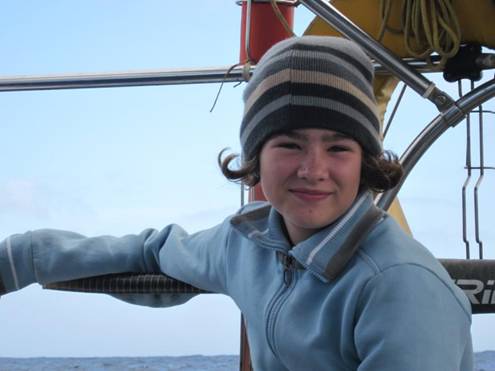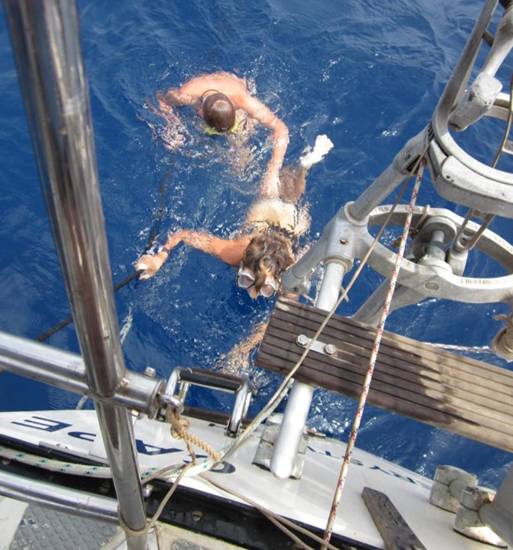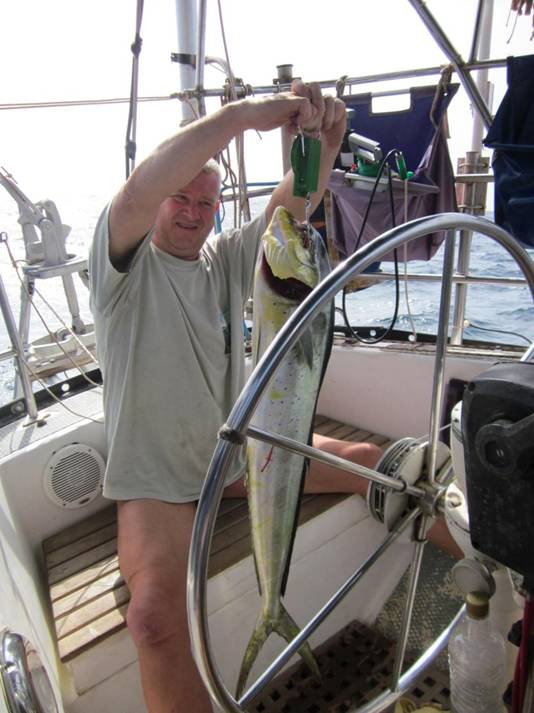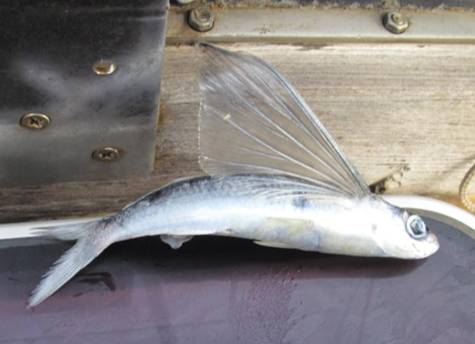Our Atlantic Crossing: The Good, The Bad and The Ugly

We left Lamin Lodge, Banjul in The Gambia at 13:10 on 28 February, and tied up alongside the Coast Guard quay in Scarborough, Tobago 23:20 on 24 March. We took the ‘scenic route’, heading south a bit (to avoid the Cape Verdes and in search of historically ‘kind’ wind and current conditions) before turning west. Our passage was 2753 miles (which means that we now qualify as full Ocean Cruising Club members) and took us 26 days, 8 hours and 30 minutes. Our speed varied from sailing at 8 knots, surfing down waves at 10 knots, and bobbing at 0.1 knots; overall, our average speed for the passage was 4.3 knots. All of the sailing mags do a run down of the highs and lows of each season’s Atlantic crossings – here’s our version of The Good, The Bad, and The Ugly. The Good Jackie and Stu’s one-stop weather shop: Jackie and Stu’ back in the UK were stars – providing weather information and updating our blog position (a gremlin in the Iridium modem meant that we couldn’t do this by e-mail ourselves). Jackie texted us the weather forecast every morning on the sat phone, and we texted her back our midday position. The weather that they arranged for us was fantastic – basically a NE 4–5 and mainly fair (with the odd patch of E 3 and a bit of drizzle, for variety) for the duration of the trip. The Iridium satellite phone and SSB radio: Having the sat phone and SSB meant that we were able to stay in touch with HEYMEDE and AQUAMARIJN in St Lucia, Jackie and Stu, and folks back in the UK/Ireland. Thanks to Mandie & Mike for their message and to Karen & Richard for trying to wish us well – it helps if I let people know what our sat phone number is! It is good to get messages/hear another person’s voice (other than that of your crew) when you are stuck on a small boat in the middle of a big ocean. Visual Passage Planner 2: Ton (AQUAMARIJN) told us about this neat bit of software, which uses the historical wind, tide and current data found on a routing chart to provide course options for your chosen destination. You do have to set up waypoints to avoid land and stuff, but options include a rhumb line route, a great circle route and a weather route so you make the most of the wind and current for your passage. We chose the weather route. We turned off the electronic chart plotter and used a good old paper chart and pencil to plot our course and position until we were approaching land. The Aries: This bit of kit (wind vane steering gear that keeps us on a set course relative to the wind) was invaluable, and held us on course for most of the 26 days of the passage. It does need quite a bit of wind to work effectively (we use the Autopilot if the wind is really light), but it is cheap to feed as it doesn’t eat valuable volts. I can set it up and adjust it, but – despite having sat and watched it for hours – I have yet to really understand exactly how it works (I think it might be a girl-brain thing – like never remembering how to do up ratchet straps despite having numerous hands-on tutorials).
Hidden in this picture are the Aries, the DuoGen shaft (not in tow mode), the onions and the landing net (deployed in flying fish mode). Can you spot all four items? Our sooper-dooper new solar panels: We had oodles of power from our new solar panels, which meant that we could use the SSB, switch on lights, charge Kindles and Nintendos, run the Autopilot when the winds were too light for the Aries and so on. We didn’t have to use the engine at all for charging the batteries (which is a good job really as the alternator isn’t working properly and we had a technical hitch or two which meant that we couldn’t run it anyway!). The DuoGen: Whenever we were sailing well we used the DuoGen on tow mode. We are still impressed with this bit of kit 5 years on and more than 11,000 miles into our trip. Bethany and Bryn: B&B stood full watches for the whole of the crossing, so we had a luxurious 2 hours-on, 6 hours-off watch system. They stood their watches (including night watches, keeping the log book and position plotting), trimmed sails, took turns being cook for the day, baked bread, carried out rig checks, and did their share of keeping the boat tidy and washing up – despite being really quite seasick at times. I think it was day 10 when they stopped throwing up regularly. Bryn was particularly bad – we tried anti-nausea tablets, wrist bands, various forms of ginger, bland food, liquids only, eating little/eating lots, hand-steering, singing loudly, telling jokes... Considering that we were all cooped up together with no escape for the best part of a month, we all got on incredibly well – there were raised voices and choice words from the two big kids a couple of times, but B&B were mature in their approach and didn’t stoop to that low level. They both remained cheerful and positive for the bulk of the trip and in spite of all of the chucking. We are delighted and proud to have them as crew as well as kids.
Beth dressed for Swimming in 5300 metres of water: The three kids went in for a swim mid-Atlantic; even without sails up, we were drifting at 2 knots, so it was actually more of a drag than a swim (tethered to CAPE by harnesses and safety lines with a knotted rope and fender to hang on to).
Swimming in 5300 metres of water: “It’s very blue down there, Mum”. Keeping busy: Nearly a month at sea – what did we do with all that time? When we weren’t catching up on sleep, preparing meals or tweaking sails, we read, did quizzes and puzzles, sewed, sang, listened to music, watched the waves, the stars and the phosphorescence, chatted and daydreamed. The kids also sketched, played their Nintendos, watched the odd film, and caught up on some maths – they finished off workbooks, turning the pages into paper aeroplanes and flying them off the back of the boat. They wanted to learn the Welsh national anthem properly (they were only 7 and 9 years when we left and have only heard it on the telly when watching Wales play rugby since leaving...), so we blasted Mae Hen Wlad fy Nhadau out across the waves on most days. I finally finished the Celtic cross-stitch bookmark that we bought when we got married 15 years ago (just as we have migrated to e-books...). Bryn and I tweaked our potato and onion pancake recipe a few times. My new, bought-especially-for-the-trip MP3 player was a dead loss – it held charge for 15 minutes or less despite charging for a full day – luckily I was able to play music and other MP3 files (Radio 4 Women’s Hour podcasts, etc.) on my Kindle. We celebrated Beth’s 14th birthday (a low-key chocolate cake affair without the traditional fork handles) but she will have an official birthday meal in Tobago too. Our Trinidad & Tobago courtesy flag: We weren’t able to buy a T&T courtesy flag before we left the Canaries, and it isn’t the sort of thing that can be bought in The Gambia, so I made our flag on passage. It is amazing what a girl can do with her sewing machine on the floor of the saloon and a bit of ‘rufflette’ curtain header tape, some black hair ribbon and an old red ensign...
Hoisting our home-made T&T courtesy flag. The food: What did we eat? We were able to store well before leaving the Gambia; there was a good selection of tinned and dried stores and a wide range of fruit, salad and veg (although it was hard to find under-ripe produce that was going to keep for our month’s crossing). We could have bought frozen bacon, burgers, sausages, fish and chicken, but as we only have a fridge not a freezer, we only carried enough fresh meat for the first couple of days. We had brought cured meats (jamon, salami and chorizo) and a selection of vacuum-packed cheeses with us from Spain especially for the crossing. We tend not to carry tinned complete meals (we find that they are expensive and it is hard to find good stuff), so we cooked ‘from scratch’ using a mixture of fresh, tinned and dried ingredients, such as: corned beef spaghetti Bolognese and chilli con carne, pizza, pancakes (plain with sweet toppings, and savoury such as potato and onion, and peas and curry spices), pasta with sauces (tomato, mushroom, carbonara), various curries (lentil, egg, dhal, aubergine), roasted veg domada (the Gambian version of satay – a garlicky, ground peanut sauce), home-made baked beans with crusty bread (we ran out of tinned baked beans a couple of months ago), refried bean wraps, tuna salad wraps, and mahi-mahi when we struck lucky on the fishing front. Lighter meals/breakfasts included soups, salads, sandwiches, hummus, cereals, pate, cheese and crackers, toast and honey/marmite/peanut butter, tapas, biltong, fresh, stewed and dried fruit, etc. We baked bread every other day, cakes/puddings occasionally and also made yogurt. We tended to eat our main meal as a late lunch, as it was light enough to see what we were eating and everyone was awake then. While cooking was sometimes a bit of a juggling act due to the Atlantic roll, it wasn’t bad enough for me to have to resort to my yellow ‘galley-slave strap’. Reaching the half-way point: Reaching half way felt really great, but crew enthusiasm flagged a bit in the following few days as we realized that we still had another couple of weeks at sea ahead of us. The last 5 days were the worst – mainly because we were excited about being nearly there! The T&T Coast Guard: In true CAPE style, we didn’t like to just sail in quietly, we made a grand entrance behind the Coast Guard boat... We were 20 miles off Tobago (motoring as it was flat calm) when our heat exchanger gave up. We bobbed on, trying a variety of unsuccessful repair approaches. By now we were bobbing – assisted by the swell, current and what little wind there was – onto reefs and a lee shore (the rocky, rough, Atlantic coast of Tobago). We gave in and requested assistance from the Trinidad & Tobago Coast Guard. They towed us in, in the dark through a 2.5 metre swell for the last 12 miles – we went through the first tow rope and were nearly through the second one when they got us alongside. The scariest bits were when the (stonking great) Coast Guard boat came close enough to get the tow lines to us, and then being towed on a very short tow by a boat designed to do 40 knots. We did get a tour of their boat the next morning though – very impressive! Thanks to the guys on TTS TEAK who towed us in, and the Scarborough-based crews who brought us alongside and have put up with us since; hopefully we will be out of your way soon!
TTS TEAK; the guns are for real. Wales won the Grand Slam: Especially for Bethany’s birthday, Wales won the Grand Slam. This is the third Grand Slam in 8 years and the second to fall on Beth’s birthday. We suggest that the WRU arrange for all crucial Wales’ fixtures to be played on March 17 in future; we can arrange for Bethany (and hangers-on) to be present in person if they insist. The Bad The infamous ‘Atlantic roll’: The rolling wasn’t too bad – we soon got used to it and only noticed it if it was particularly violent. It was worst when we had light winds as we wallowed, and when the wind was from directly behind (we don’t have a dedicated downwind sail to harness this) but CAPE was quite stable and didn’t roll too much when she was romping along in a decent breeze. We had a couple of patches with big swell (3.5 metres) as a result of bad weather around the Azores, which made sleeping a bit difficult, but we wedged ourselves in with lee cloths and cushions and dozed during the day to catch up on sleep. Catching lots of Sargasso weed and only 1 edible fish: We only caught 1 decent-sized fish – a 4.5 kg mahi-mahi (dolphin fish) on Day 25. We also caught a couple of large squid tentacles and a gar fish (the gar fish was too small to eat, so we put him back). A couple of decent sized fish got away and we had a small swordfish chase our lure on the surface – but he didn’t bite. We caught so much Sargasso weed that we got fed up of clearing the lure every half an hour and didn’t fish for most of the trip.
Rafts of Sargasso weed snagged our fishing lures and the DuoGen turbine.
The one that didn’t get away – a 4.5 kg mahi-mahi (dolphin fish). Lidl’s tinned macaroni cheese: not to be recommended. The lack of wildlife: After seeing lots of whales/dolphins in the lower reaches of the Gambia River, and being escorted from Banjul by dolphins, we were disappointed at the lack of wildlife once we got out to sea – whole weeks went by without seeing even a bird! We were delighted when we did see signs of life: ● two huge leatherback turtles ● quite a few Portuguese man-o’war ‘jellyfish’ (15 cm or so, bright pink/purple floating ‘things’ that looked like inflated novelty condoms or something that Barbie might have dropped overboard by accident) ● three pods of dolphins; we were able to identify positively a pod of clymene dolphin (Stenella clymene) and a pod of Atlantic spotted dolphin (Stenella frontalis), and were pretty sure that the third pod was pygmy killer whale (Feresa attenuata) ● on the bird front we saw a few unidentified seabirds mid-ocean, and were inspected from on high by a couple of red-billed tropic birds (there is no mistaking their distinctive tail) ● the phosphorescence was amazing – it wasn’t just the usual sparkles in the water creaming off our hull and in our wake – we also had groups of squid (which flashed like soft-tone bulbs underwater), and glowing blobs on the surface alongside (possibly the Portuguese men-o’war?) ● we did see lots of flying fish, ranging in size from whitebait-with-wings to airborne mackerel. Would the collective noun for flying fish be a shoal as in fish or a flock as in birds? We decided on a shock of flying fish – as groups of them often explode out of the water together. Quite a few found their way on deck and a couple hit us or landed in the cockpit; unfortunately we usually didn’t find the ones on deck until they were desiccated.
An ex-flying fish. Technical hitch number 544 at least: We ran the engine each week to make sure that everything was OK. On one occasion, it started but stalled and wouldn’t restart. David investigated and found a blocked diesel line – a result of having to use compressed air hose instead of the real McCoy (all we could get hold of in Greece). David fitted a new primary filter and two new fuel lines. Get hold of a set of proper fuel lines went onto the list of jobs to be done... Technical hitch number – no longer counting: The non-Volvo heat exchanger that David and Colin cobbled together (also in Greece) failed, resulting in mixing of the sea and fresh water and boiling sea water spilling from the header tank into the engine room. David tried various repair approaches, but with no success, so we made our call to the Coast Guard. The Ugly Only washing (properly) 4 times in 26 days: hum! Even so, we had a huge pile of washing by the end. We did have baby wipes and a small amount of water for anointing those ‘important little places’ in between getting wet all over. We carried 700 litres of drinking water for the trip (500 litres in tanks and 200 in jerry cans/bottles); we used this only for drinking, cooking, washing fruit, veg and faces, and cleaning teeth. We washed up in sea water and rinsed the dishes with a small amount of fresh. We used 500 litres of our drinking water on the passage. If we were to do it again, would we do anything different? Knowing what we know now, the things that we would change on an Atlantic crossing (of those things that we could control, of course!) would be: ● To have a dedicated downwind sail ● To carry more onions! You can get in touch with us via sarahsmith dot phd at gmail dot com. © 2012. All materials (text and photographs) in this blog (unless stated otherwise) are the property of Sarah and David Smith. Copyright and other intellectual property laws protect these materials. Reproduction or retransmission of the materials, in whole or in part, in any manner, without the prior written consent of the copyright holder, is a violation of copyright law. |







